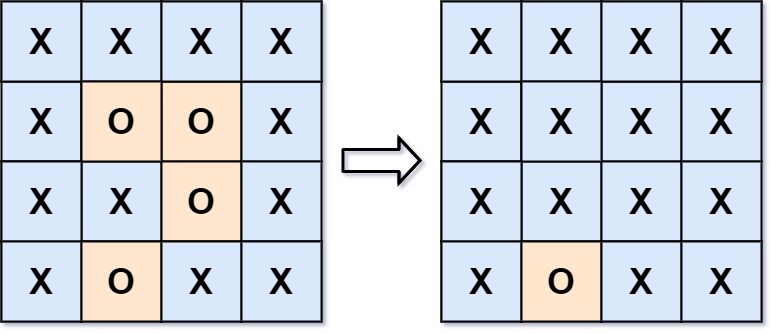Surrounding Regions
ID: 130
Given an m x n matrix board containing 'X' and 'O', capture all regions that are 4-directionally surrounded by 'X'.
A region is captured by flipping all 'O's into 'X's in that surrounded region.

Input: board = [["X","X","X","X"],["X","O","O","X"],["X","X","O","X"],["X","O","X","X"]]
Output: [["X","X","X","X"],["X","X","X","X"],["X","X","X","X"],["X","O","X","X"]]
Explanation: Surrounded regions should not be on the border,
which means that any 'O' on the border of the board are not flipped
to 'X'. Any 'O' that is not on the border and it is not connected to
an 'O' on the border will be flipped to 'X'.
Two cells are connected if they are adjacent cells connected
horizontally or vertically.Idea
DFS requires less coding, so DFS
Check the borders of the matrix and see index with value 'O'. Do DFS from this specific value to see all connected components to this border and update them to an arbitrary value, like '#'
Iterate all elements in matrix and update all other 'O' to 'X' since these are not connected to border, and update all '#' to 'O' since they are border 'O's that cannnot be flipped
Code
public void solve(char[][] board) {
int m= board.length;
int n = board[0].length;
for(int i=0;i<m;i++){
for(int j=0;j<n;j++){
if((i==0||i==m-1||j==0||j==n-1) && board[i][j]=='O')
dfs(board,i,j,m-1,n-1);
}
}
for(int i=0;i<m;i++){
for(int j=0;j<n;j++){
if(board[i][j]=='O')
board[i][j]='X';
else if(board[i][j]=='#')
board[i][j]='O';
}
}
}
public void dfs(char[][] board,int i,int j,int ROW,int COL){
if(i<0||i>ROW||j<0||j>COL||board[i][j]=='#'||board[i][j]=='X')
return;
board[i][j]='#';
dfs(board,i+1,j,ROW,COL);
dfs(board,i-1,j,ROW,COL);
dfs(board,i,j+1,ROW,COL);
dfs(board,i,j-1,ROW,COL);
return;
}Last updated